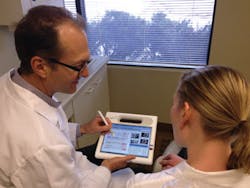Location independence for your practice management system
By Marty Jablow, DMD
So how do we free ourselves from the confines of a paper chart? We do this by rethinking how we use our practice management software. Most software has been written with the paper chart flow in mind. So the center of the paper chart universe is the front desk. The reality is that the center of the universe for your dental practice is the patient. The patient is always on the move. At various times during the appointment, a patient may occupy a different physical space in your office. An example is taking a Panorex or cone beam image and then leading the patient back to the treatment room. The problem with paper or a fixed computer location is that the information does not always move efficiently with the patient. This problem still occurs in most chartless dental offices since the workflow has not really changed but simply become a virtual chart instead of a physical one. Although chartless is more efficient than paper, the workflow needs to be updated.
Let's start with the initial patient encounter. After the new patient emails the office requesting an appointment and the appointment is scheduled, an email should be sent to the patient with a link to fill in their initial encounter forms online before coming to the dental office. This frees the staff from data entry, cuts down on transcription errors, and allows the appointment to proceed on time.
Once in the office, data entry can be easily entered wherever the patient may be in the practice through the use of tablets. XLDent is a practice management software that has been optimized for use on tablets, giving the staff the freedom to roam the office. The tablet simplifies data entry at the point of the procedure, not the location of the computer. By entering data at the point of origin, you will reduce the error rate of procedural entry and be able to enter more comprehensive chart notes. Your office data will now be available where and whenever you need it. Reviewing charts at that morning huddle can be more comprehensive, and the tablet can be shared if data needs to be reviewed by others.
The tablet can be used with your digital radiography system. Simply bring the tablet to the patient, plug in the sensor, and use a handheld X-ray head such as an Aribex Nomad to produce radiographs. Import the photographs via a wireless Eye-Fi card from a digital camera, and make the diagnosis. You have the freedom to do the examination in any room in the office.
With a tablet, you can sit next to a patient and go through patient education videos and discuss needed treatment. It is no longer a show and tell, but a very personal way of educating patients in a nonthreatening way. It is more of a codiagnosis. Afterward, you just hand the patient the tablet to review and sign the informed consent.
After you render treatment, you can make chart entries from anywhere in your office. You can schedule a follow-up appointment from the treatment room and even take payment, or the patient can go to the front desk and the administrative staff can easily process the insurance claim and collect the copayment, hand the patient the tablet to sign for the charge, and then email them a copy of the receipt. Once the patient makes a follow-up appointment, he or she is immediately emailed a new appointment confirmation.
Tablets are becoming more mainstream, and although they are more expensive than desktops, the freedom they provide allows for a reduced number of office computers. So your actual costs may be less than if you were outfitting an office with conventional chartless hardware. The best part is that you gain the freedom to enter data wherever the patient is and wherever it is convenient for you.
The chartless office gives you an opportunity to break old habits, establish a patient centric workflow, and become much more efficient.
MARTIN JABLOW, DMD, is a clinician, speaker, and author. He presents and publishes worldwide on many topics, including state-of-the-art dental technology and dental materials. Dr. Jablow is president of Dental Technology Solutions, a lecture and consulting company. He may be reached at [email protected].
Past DE Issues

